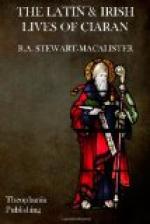Is fort shnadud cach ambi ria ndula
m’ chri, a Ri slan,
ic do guide dam cen dichil, an rimm
a Ri richid ran
(On Thy protection is every one whereso he is; before departure of my body, O Perfect King, I am praying Thee without negligence, stay for me, O King of glorious heaven.)
LIV. THE PANEGYRICS (LA, VG)
There is little that need be said about these paragraphs, which are of conventional type. There are two references in VG which may, however, be noted. The first is to the relics left in the hollow elm, of which we have already heard at the beginning of these annotations: here said to have been deposited by Benen (the pupil of Patrick, and his successor in Armagh) and by Cumlach (the leper of Saint Patrick). The second is an allusion, on which I am unable to throw any light, to some evidently well-known story of a certain Peca and his blind pupil.
THE METRICAL PANEGYRIC IN LB
This is a patchwork of extracts from different sources.
1. Fifteen-syllable lines, with caesura at eighth syllable; every line ending in a trisyllabic word, rhyming (not always) with a word preceding the caesura. A dissyllable or trisyllable precedes the caesura. Rhythm of Tennyson’s Locksley Hall, proceeding by stress only, independent of vowel-quantity or hiatus. In line seven, ‘Keranus’ must be pronounced in four syllables, Kiaranus. Refers to the wizard’s prophecy, incident II.
2. Four lines, in Locksley Hall rhythm, with a dissyllabic rhyme running through the quatrain. Relates incident IX.
3. Four lines, twelve syllables trochaic, caesura at seventh syllable. Each line ends with a trisyllable or a tetrasyllable, with dissyllabic rhyme running through the quatrain. The rhythm is that of the following line (which is intentionally misquoted to serve the present purpose)—
“Gather roses while you may, time is still a-flying.”
The incident is not recorded in the prose lives; but it appears in the Book of the Dun Cow, in the story of the Birth of Aed Slaine (son of King Diarmait, reigned A.D. 595-600). Diarmait, it appears, had two wives (for, notwithstanding his friendship to Ciaran, he was but a half-converted pagan), by name Mugain and Muireann. Muireann had the misfortune to be bald, and Mugain, who, as is usual in polygamous households, was filled with envy of her, bribed a female buffoon to remove her golden headgear in public at the great assembly of Tailltiu (Telltown, Co. Meath), so as to expose the poor queen’s defect to the eyes of the mob. The messenger accomplished her purpose, but Muireann cried out, “God and Saint Ciaran help me in this need!” and forthwith a shower of glossy curling golden hair flowed from her head over her shoulders, before a single eye of the assembly had rested upon her. Compare Ciaran’s own experience, incident XLVI.




